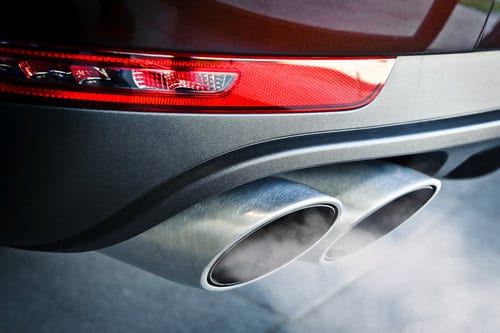
In the wake of the emissions scandal that has engulfed Volkswagen in the United States and Europe, it’s worth asking: how do Australia’s standards stack up? The awful truth: we’re literally years behind Europe and the US.
VW has been caught out for installing devices to game emissions tests in the United States, after an environmental group found discrepancies between on-road emissions of nitrogen oxides and testing conditions.
Emissions standards are important to improve air quality and reduce the effects of air pollution. Diesel exhausts of nitrogen oxides (NOx) and particulate pollutions are a major health concern.
Australia has adopted international standards, which have been developed by the United Nations and referred to as “Euro standards”. The Euro standards regulate the emission standards of nitrogen oxides (NOx), hydrocarbons, carbon monoxide, particulate numbers and particulate materials. (Cars also produce greenhouse gases, which contribute to climate change, but these are usually regulated in a different way.)
All new vehicles manufactured or sold in the country must comply with the standards, which are tested by running the vehicle or engine in a standardised test cycle.
The story overseas
Euro standards apply to the air pollutants, while separate regulatory emission standards apply to CO2 emissions.
The Euro standards vary depending on whether the vehicle uses petrol or diesel, as well as the class of the vehicle. For instance, the Euro 5 standard reduced the amount of particulate matter for diesel vehicles from the previous standards by 80% (from 25 milligrams per km to 5 mg/km) and by 28% for NOx emissions (from 250 mg/km to 180 mg/km). The adoption of Euro 5 standards has forced the use of diesel particulate filters for light–duty diesel vehicles.
The Euro 6 standard will reduce NOx emissions by a further 55%, and narrow the gap to the petrol engine emissions standard of 60 mg/km.
The International Council on Clean Transportation states that:
Euro 6 limits bring overall emissions of diesel and petrol vehicles close to parity, provided that vehicles of both fuel types conform to standards in real-world driving conditions.
In the European Union (EU), the Euro 5 standard applied to the sale of all new vehicles from January 2011 until September 2015. From September 2015, all new vehicles sold in the EU must be Euro 6-compliant.
In the United States the standards (referred to as the Tier 2 program) are more stringent than Euro 6, with the fleet average NOx close to 40 mg/km for both diesel and petrol engines. The Tier 2 program sets out the standards for tailpipe emissions for all passenger vehicles including sports utility vehicles (SUVs, minivans, and pick up trucks). Tier 2 will be replaced by stricter Tier 3 standards at the beginning of 2017.
CO2 emission standards are regulated in the EU and US. In 2009 the European Union introduced regulatory CO2 emission targets of 130g of CO2/km by 2015 from new passenger vehicles sold by all car manufacturers combined.
In the United States, the federal Corporate Average Fuel Economy is equivalent to 160g of CO2/km, by 2016.
Australia needs to catch up
Australian emission standards lag well behind EU and US standards.
Australia has no regulatory CO2 emission standards to reduce emissions of greenhouse gas emissions from fossil fuels and its impact on climate change. This allows car manufacturers and importers to dump their high CO2 emitting vehicles because there are no restrictions.
The government has signalled that vehicle efficiency will form part of policies to meet Australia’s future climate target.
Australia’s current air pollutant standards are Euro 4, which were fully implemented by July 2010. The Euro 5 standards will not apply until November 1, 2016 and the Euro 6 standards will take effect from April/July 2017 and April/July 2018 for all models.
Failure to impose the current international standards means importers of new vehicles can dump high-polluting Euro 4 compliant vehicles into Australia, which cannot be sold in their own country. For instance the Swiss authorities have banned the sale of almost 180,000 Volkswagen diesel vehicles, because the company has fraudulently falsified the vehicles’ diesel emission standards, which are no longer Euro 5 compliant. However, such VW vehicles may be Euro 4 compliant and can be sold in Australia.
It is unlikely Australia will meet the most current international emission standards until the cessation of local manufacturing motor vehicle industry towards the end of 2017. Not all local vehicles are Euro 5 compliant, which makes it an expensive proposition to keep all vehicles in production.
Furthermore the Gillard government supported the struggling industry by amending the Commonwealth Fleet Vehicle Selection Policy in 2012, and mandated a 100% Australian-made passenger motor vehicle fleet for all commonwealth agencies. That is, the regulation required government buyers to select passenger and light commercial vehicles manufactured in Australia unless it could be “demonstrated that no suitable vehicle is available”.
The regulation stated that “environmental considerations“ are not a consideration for choosing an alternative vehicle. The purpose of the fleet procurement policy is to provide support to the Australian car industry. However there is limited scope for government support through fleet purchases, which are mostly from the Commonwealth, Victoria and South Australian governments. Further, all governments accounted for 41,925 sales in 2014, representing only 3.8% of total vehicle sales.
Clearly government intervention is required to upgrade the emission standards for air pollutants and prevent car manufacturers or importers from dumping high-polluting vehicles in Australia.
Source: The Conversation. Reproduced with permission.







